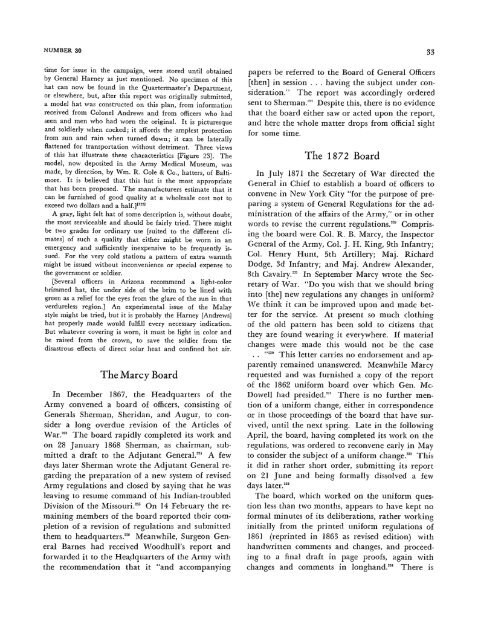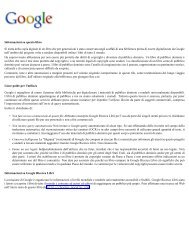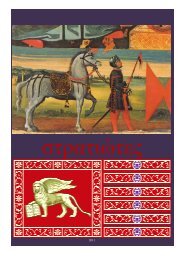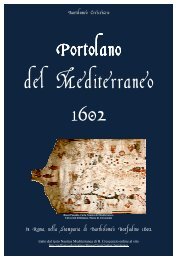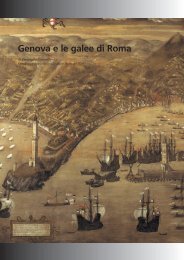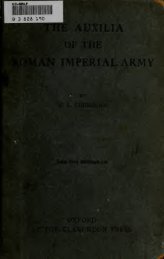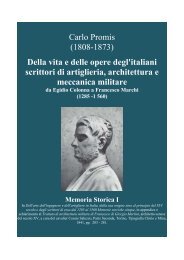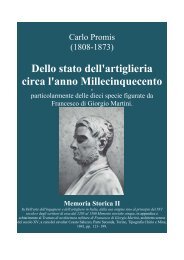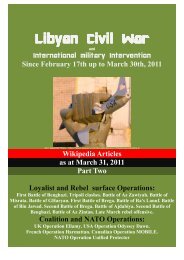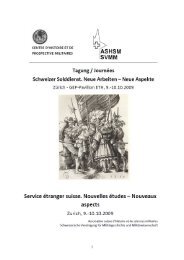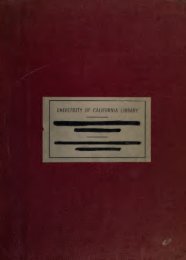United States Army Headgear 1855-1902 - Libreria Militare Ares
United States Army Headgear 1855-1902 - Libreria Militare Ares
United States Army Headgear 1855-1902 - Libreria Militare Ares
- No tags were found...
You also want an ePaper? Increase the reach of your titles
YUMPU automatically turns print PDFs into web optimized ePapers that Google loves.
NUMBER 30 33time for issue in the campaign, were stored until obtainedby General Harney as just mentioned. No specimen of thishat can now be found in the Quartermaster's Department,or elsewhere, but, after this report was originally submitted,a model hat was constructed on this plan, from informationreceived from Colonel Andrews and from officers who hadseen and men who had worn the original. It is picturesqueand soldierly when cocked; it affords the amplest protectionfrom sun and rain when turned down; it can be laterallyflattened for transportation without detriment. Three viewsof this hat illustrate these characteristics [Figure 23]. Themodel, now deposited in the <strong>Army</strong> Medical Museum, wasmade, by direction, by Wm. R. Cole & Co., hatters, of Baltimore.It is believed that this hat is the most appropriatethat has been proposed. The manufacturers estimate that itcan be furnished of good quality at a wholesale cost not toexceed two dollars and a half.]''"'A gray, light felt hat of some description is, without doubt,the most serviceable and should be fairly tried. There mightbe two grades for ordinary use [suited to the different climates]of such a quality that either might be worn in anemergency and sufficiently inexpensive to be frequently issued.For the very cold stations a pattern of extra warmthmight be issued without inconvenience or special expense tothe government or soldier.[Several officers in Arizona recommend a light-colorbrimmed hat, the under side of the brim to be lined withgreen as a relief for the eyes from the glare of the sun in thatverdureless region.] An experimental issue of the Malaystyle might be tried, but it is probably the Harney [Andrews]hat properly made would fulfill every necessary indication.But whatever covering is worn, it must be light in color andbe raised from the crown, to save the soldier from thedisastrous effects of direct solar heat and confined hot air.The Marcy BoardIn December 1867, the Headquarters of the<strong>Army</strong> convened a board of officers, consisting ofGenerals Sherman, Sheridan, and Augur, to considera long overdue revision of the Articles ofWar."' The board rapidly completed its work andon 28 January 1868 Sherman, as chairman, submitteda draft to the Adjutant General."' A fewdays later Sherman wrote the Adjutant General regardingthe preparation of a new system of revised<strong>Army</strong> regulations and closed by saying that he wasleaving to resume command of his Indian-troubledDivision of the JVTissouri."^ On 14 February the remainingmembers of the board reported their completionof a revision of regulations and submittedthem to headquarters."" Meanwhile, Surgeon GeneralBarnes had received Woodhull's report andforwarded it to the Hea^dquarters of the <strong>Army</strong> withthe recommendation that it "and accompanyingpapers be referred to the Board of General Officers[then] in session . . . having the subject under consideration."The report was accordingly orderedsent to Sherman."^ Despite this, there is no evidencethat the board either saw or acted upon the report,and here the whole matter drops from official sightfor some time.The 1872 BoardIn July 1871 the Secretary of War directed theGeneral in Chief to establish a board of officers toconvene in New York City "for the purpose of preparinga system of General Regulations for the administrationof the affairs of the <strong>Army</strong>," or in otherwords to revise the current regulations."^ Comprisingthe board were Col. R. B. Marcy, the InspectorGeneral of the <strong>Army</strong>, Col. J. H. King, 9th Infantry;Col. Henry Hunt, 5th Artillery; Maj. RichardDodge, 3d Infantry; and Maj. Andrew Alexander,8th Cavalry."^ In September Marcy wrote the Secretaryof War. "Do you wish that we should bringinto [the] new regulations any changes in uniform?We think it can be improved upon and made betterfor the service. At present so much clothingof the old pattern has been sold to citizens thatthey are found wearing it everywhere. If materialchanges were made this would not be the case. . """ This letter carries no endorsement and apparentlyremained unanswered. Meanwhile Marcyrequested and was furnished a copy of the reportof the 1862 uniform board over which Gen. McDowell had presided.'" There is no further mentionof a uniform change, either in correspondenceor in those proceedings of the board that have survived,until the next spring. Late in the followingApril, the board, having completed its work on theregulations, was ordered to reconvene early in Mayto consider the subject of a uniform change.'" Thisit did in rather short order, submitting its reporton 21 June and being formally dissolved a fewdays later.'"The board, which worked on the uniform questionless than two months, appears to have kept noformal minutes of its deliberations, rather workinginitially from the printed uniform regulations of1861 (reprinted in 1863 as revised edition) withhandwritten comments and changes, and proceedingto a final draft in page proofs, again withchanges and comments in longhand.'^' There is


